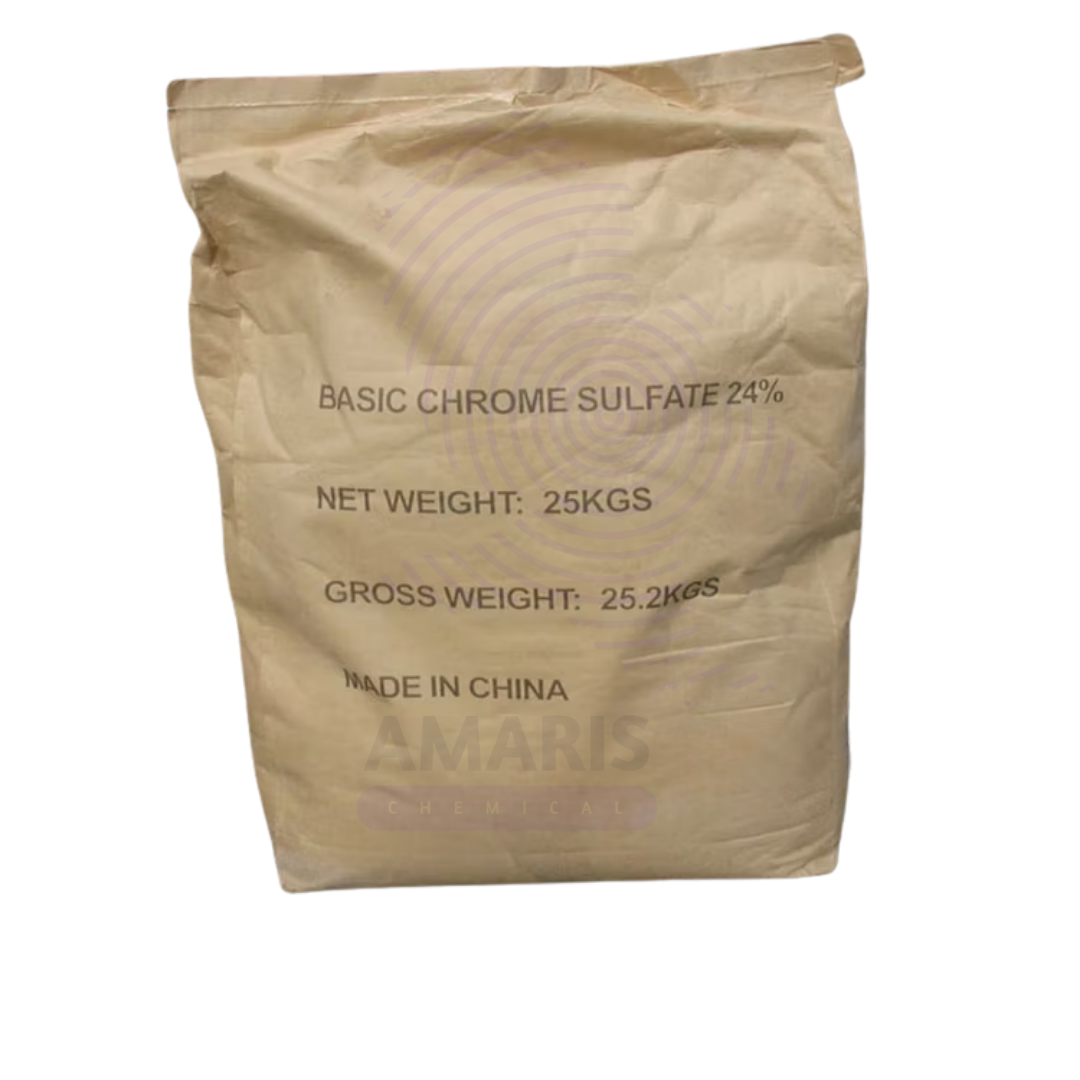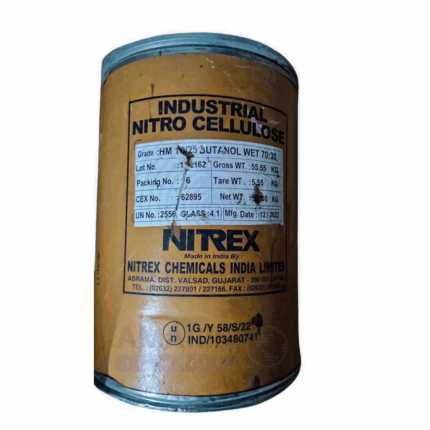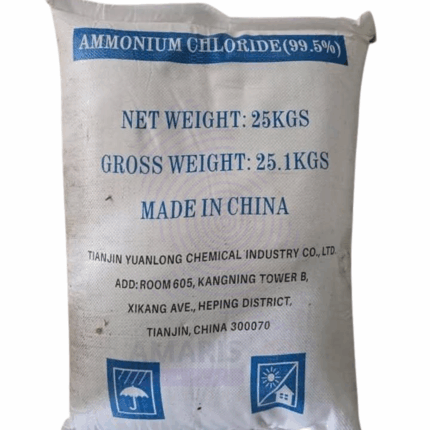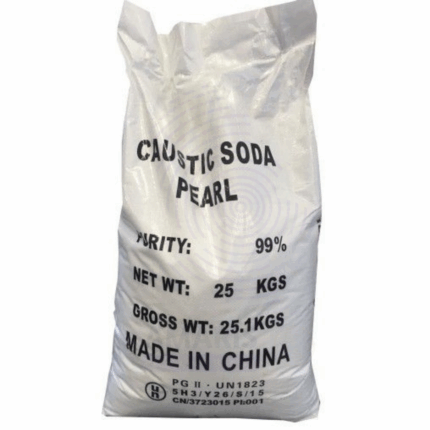Basic Chrome
Whatsapp Order
Basic Chrome Sulfate, commonly referred to as Basic Chrome, is a chromium-based chemical compound primarily used in the leather tanning industry. It appears as a greenish crystalline powder and contains chromium(III) sulfate complexed with basic chromium salts. Basic Chrome is favored for its ability to produce soft, flexible, and durable leather by crosslinking collagen fibers. It is the most widely used tanning agent worldwide due to its effectiveness and cost-efficiency. Besides tanning, Basic Chrome finds applications in other industries like pigments and catalysts.
Description
Table of Contents
Toggle
Basic Chrome
Primary Uses
Leather Tanning
- Acts as the principal chromium tanning agent to convert raw hides into leather.
- Imparts softness, durability, and water resistance to leather products.
- Enhances leather’s resistance to heat and microbial degradation.
Pigment Industry
- Used in the manufacture of chrome green pigments for paints, inks, and coatings.
Catalyst Applications
- Employed in certain chemical processes as a catalyst or catalyst precursor.
Secondary Uses
- Used in textile dyeing and printing as a mordant to fix dyes.
- In wastewater treatment, chromium compounds derived from Basic Chrome can be used in coagulation processes.
- Research applications in materials science involving chromium complexes.
PRODUCT KEY FEATURES
- Basic Identification Attributes
- Chemical Name (IUPAC): Chromium(III) sulfate basic salt (approximate)
- Common/Trade Names: Basic Chrome, Basic Chrome Sulfate, Basic Chromium Sulfate
- CAS Number: 141-47-7 (approximate, may vary by exact formulation)
- HS Code: 3206.40.00
- Molecular Formula: Variable; commonly represented as Cr₂(OH)₃SO₄·xH₂O
- Synonyms: Chromium sulfate basic, basic chromium sulfate, chromium(III) basic sulfate
- Physical & Chemical Properties
- Physical State: Greenish crystalline powder or granules
- Color & Odor: Green to bluish-green, odorless
- Melting Point: Decomposes before melting, >300°C
- Boiling Point: Not applicable (decomposes)
- Density: Approx. 2.5 – 2.9 g/cm³ (varies by hydration)
- Solubility: Soluble in water forming acidic solutions
- pH Level: Acidic to slightly acidic in aqueous solution (~3-5)
- Vapor Pressure: Negligible
- Flash Point: Non-flammable
- Safety & Hazard Attributes
- Hazard Class (GHS): Harmful if swallowed; may cause allergic skin reactions; suspected carcinogen (chromium III generally less toxic than chromium VI)
- NFPA Ratings: Health 2, Flammability 0, Reactivity 1
- Exposure Limits: OSHA PEL (Chromium compounds, insoluble): 0.5 mg/m³ (as Cr)
- Reactivity: Stable under normal conditions; reacts with strong oxidizers and bases
- Toxicity: Chromium compounds can cause skin sensitization and respiratory issues
- Storage & Handling Attributes
- Storage Conditions: Store in a cool, dry, well-ventilated area away from incompatible substances (e.g., strong bases, oxidizers)
- Container Type: Sealed, corrosion-resistant containers (plastic or coated metal)
- Shelf Life: Typically stable for several years if stored properly
- Special Handling: Avoid dust generation; use PPE including gloves, masks, and eye protection
- Regulatory & Compliance Attributes
- Regulatory Status: Regulated due to chromium content; chromium III is less restricted than chromium VI
- Transportation: Non-flammable solid, subject to hazardous material regulations depending on concentration and packaging
- Waste Disposal: Dispose of chromium-containing waste per local environmental regulations
- Environmental & Health Impact
- Ecotoxicity: Toxic to aquatic life; avoid release to waterways
- Persistence: Chromium III tends to bind strongly to soils and sediments; low mobility
- Carcinogenicity/Mutagenicity: Chromium III compounds less carcinogenic than chromium VI, but chronic exposure should be minimized
- Biodegradability: Inorganic compound, not biodegradable
SAFETY HANDLING PRECAUTIONS
Safety Handling Precautions
- PPE: Wear gloves, safety goggles, and protective clothing to avoid skin and eye contact. Use dust masks or respirators if airborne dust is present.
- Handling: Avoid inhalation and prolonged skin exposure. Use local exhaust ventilation to control dust.
- Storage: Keep container tightly closed and store in a dry place away from incompatible substances.
- Hygiene: Wash hands thoroughly after handling. Do not eat or smoke in the handling area.
First Aid Measures
- Inhalation: Move to fresh air immediately. Seek medical attention if breathing difficulties occur.
- Skin Contact: Wash with soap and water. Seek medical advice if irritation or allergic reaction develops.
- Eye Contact: Rinse with plenty of water for at least 15 minutes. Seek medical attention if irritation persists.
- Ingestion: Do not induce vomiting. Rinse mouth and seek immediate medical assistance.
Firefighting Measures
- Fire Hazards: Non-flammable but may decompose on heating releasing toxic chromium oxides.
- Extinguishing Media: Use water spray, foam, dry chemical powder, or CO₂.
- Special Precautions: Firefighters should wear protective gear and self-contained breathing apparatus (SCBA).
Related products
Ammonium Chloride
Ammonium chloride is a white crystalline salt with a salty, slightly acidic taste. It is highly soluble in water and is widely used in various industrial, agricultural, and pharmaceutical applications. It acts as a nitrogen source in fertilizers, a flux in metalworking, and an expectorant in medicine. Its versatility and relatively low toxicity make it an important compound in multiple sectors.
Ammonium Cupric Chloride
Ammonium Cupric Chloride is a blue-green crystalline inorganic compound composed of copper, ammonium, and chloride ions. It is widely used as a source of copper in agricultural fungicides and bactericides, as well as in electroplating, chemical synthesis, and textile dyeing. Its antimicrobial properties make it valuable for controlling fungal and bacterial infections in plants. Additionally, it serves as a precursor in various industrial and laboratory applications.
Amprolium Hydrochloride BP USP
Amprolium Hydrochloride is a white, odorless, crystalline powder used primarily as a coccidiostat, which means it inhibits the growth of Eimeria species (protozoan parasites) responsible for coccidiosis in poultry and other animals. It works by mimicking thiamine (vitamin B1), thereby competitively inhibiting thiamine uptake by the parasite, disrupting its metabolism, and preventing its proliferation. Amprolium HCl is widely used in veterinary medicine, especially in poultry farming, and is often included in feed or drinking water. It complies with BP 2008 and USP 32 pharmacopeial standards.
Caustic Soda Pearls
Caustic Soda Pearls are small, solid, spherical particles of sodium hydroxide (NaOH) produced by a controlled cooling and solidification process. These pearls offer superior flowability, uniform size distribution, and reduced dust generation compared to flake or powder forms. They are highly soluble in water, exhibiting a strong alkaline nature with vigorous exothermic dissolution. Caustic Soda Pearls are widely used across industries including chemical manufacturing, water treatment, pulp and paper processing, and detergents due to their purity, ease of handling, and efficient dissolution characteristics.
Dicumyl Peroxide
Dicumyl Peroxide (DCP) is a widely used organic peroxide with powerful free radical initiator properties. It appears as a white crystalline solid with a characteristic odor and is primarily employed as a cross-linking agent and polymerization initiator in the plastics and rubber industries. Due to its ability to generate free radicals upon thermal decomposition, it facilitates curing and cross-linking of polymers, improving mechanical properties and heat resistance. Dicumyl Peroxide is a key component in manufacturing processes for polyethylene, polypropylene, EPDM rubber, and other elastomers.
Ethyl Glycol Acetate
Ethyl Glycol Acetate, also known as 2-Ethoxyethyl acetate, is a clear, colorless liquid solvent with a mild, sweet, and slightly fruity odor. It belongs to the family of glycol ethers and esters, combining excellent solvency power with moderate evaporation rates. This makes it highly suitable for use in coatings, inks, adhesives, and cleaning formulations where good solvency and controlled drying times are desired. Ethyl Glycol Acetate is compatible with a wide range of resins, including nitrocellulose, alkyd, acrylic, and vinyl resins, making it a versatile industrial solvent. Its balanced physical properties allow for efficient thinning, cleaning, and dissolution without rapid evaporation or harsh odors.
Ferrous Sulphide
Ferrous Sulphide (FeS) is an inorganic iron-sulfur compound appearing as a dark gray to black crystalline powder or solid. It has low solubility in water but reacts with acids to release hydrogen sulfide gas. It is used in numerous industrial and chemical processes due to its sulfide content and reactive properties. Ferrous Sulphide serves as a key intermediate in metallurgy, chemical synthesis, wastewater treatment, pigment production, and more.
Toxin Binder Premix
Toxin Binder Premix is a specialized feed additive formulated to adsorb and neutralize a broad range of mycotoxins and other harmful toxins present in animal feed. It enhances animal health by preventing the absorption of toxins in the gastrointestinal tract, thereby improving feed efficiency and productivity. The premix typically contains activated clays, yeast cell wall components, and other natural or synthetic adsorbents designed for use in livestock, poultry, and aquaculture feeds. This product supports animal growth, immune function, and overall well-being by mitigating the adverse effects of feed contamination.


 Preservatives(food)
Preservatives(food) Flavor Enhancers
Flavor Enhancers Acidulants
Acidulants Sweeteners
Sweeteners Antioxidants
Antioxidants Colorants(food)
Colorants(food) Nutraceutical Ingredients (food)
Nutraceutical Ingredients (food) Nutrient Supplements
Nutrient Supplements Emulsifiers
Emulsifiers
 Collectors
Collectors Dust Suppressants
Dust Suppressants Explosives and Blasting Agents
Explosives and Blasting Agents Flocculants and Coagulants
Flocculants and Coagulants Frothers
Frothers Leaching Agents
Leaching Agents pH Modifiers
pH Modifiers Precious Metal Extraction Agents
Precious Metal Extraction Agents
 Antioxidants(plastic)
Antioxidants(plastic) Colorants (Pigments, Dyes)
Colorants (Pigments, Dyes) Fillers and Reinforcements
Fillers and Reinforcements Flame Retardants
Flame Retardants Monomers
Monomers Plasticizers
Plasticizers Polymerization Initiators
Polymerization Initiators Stabilizers (UV, Heat)
Stabilizers (UV, Heat)
 Antifoaming Agents
Antifoaming Agents Chelating Agents
Chelating Agents Coagulants and Flocculants
Coagulants and Flocculants Corrosion Inhibitors
Corrosion Inhibitors Disinfectants and Biocides
Disinfectants and Biocides Oxidizing Agents
Oxidizing Agents pH Adjusters
pH Adjusters Scale Inhibitors( water)
Scale Inhibitors( water)
 Antioxidants(cosmetic)
Antioxidants(cosmetic) Emollients
Emollients Fragrances and Essential Oils
Fragrances and Essential Oils Humectants
Humectants Preservatives
Preservatives Surfactants(cosmetic)
Surfactants(cosmetic) Thickeners
Thickeners UV Filters
UV Filters
 Fertilizers
Fertilizers Soil Conditioners
Soil Conditioners Plant Growth Regulators
Plant Growth Regulators Animal Feed Additives
Animal Feed Additives Biostimulants
Biostimulants Pesticides (Herbicides, Insecticides, Fungicides)
Pesticides (Herbicides, Insecticides, Fungicides)
 Active Pharmaceutical Ingredients (APIs)
Active Pharmaceutical Ingredients (APIs) Excipients
Excipients Solvents(pharmaceutical)
Solvents(pharmaceutical) Antibiotics
Antibiotics Antiseptics and Disinfectants
Antiseptics and Disinfectants Vaccine Adjuvants
Vaccine Adjuvants Nutraceutical Ingredients (pharmaceutical)
Nutraceutical Ingredients (pharmaceutical) Analgesics & Antipyretics
Analgesics & Antipyretics
 Analytical Reagents
Analytical Reagents Solvents(lab)
Solvents(lab) Chromatography Chemicals
Chromatography Chemicals Spectroscopy Reagents
Spectroscopy Reagents microbiology-and-cell-culture-reagents
microbiology-and-cell-culture-reagents Molecular Biology Reagents
Molecular Biology Reagents Biochemical Reagents
Biochemical Reagents Inorganic and Organic Standards
Inorganic and Organic Standards Laboratory Safety Chemicals
Laboratory Safety Chemicals Specialty Laboratory Chemicals(Special Laboratory Equipment)
Specialty Laboratory Chemicals(Special Laboratory Equipment)
 Demulsifiers
Demulsifiers Hydraulic Fracturing Fluids
Hydraulic Fracturing Fluids Scale Inhibitors(oil)
Scale Inhibitors(oil) Surfactants(oil)
Surfactants(oil) Drilling Fluids
Drilling Fluids
 Dyes and Pigments
Dyes and Pigments Bleaching Agents
Bleaching Agents Softening Agents
Softening Agents Finishing Agents
Finishing Agents Antistatic Agents
Antistatic Agents
 Admixtures
Admixtures Waterproofing Agents
Waterproofing Agents Sealants and Adhesives
Sealants and Adhesives Curing Compounds
Curing Compounds Concrete Repair Chemicals
Concrete Repair Chemicals Anti-Corrosion Coatings
Anti-Corrosion Coatings
 Surfactants(cleaning)
Surfactants(cleaning) Builders
Builders Enzymes
Enzymes Solvents (Cleaning)
Solvents (Cleaning) Fragrances
Fragrances
 Electronic Chemicals
Electronic Chemicals Catalysts
Catalysts Lubricants
Lubricants Photographic Chemicals
Photographic Chemicals Refrigerants
Refrigerants Automotive chemicals
Automotive chemicals Pyrotechnic Chemicals
Pyrotechnic Chemicals
 Biodegradable Surfactants
Biodegradable Surfactants Bio-based Solvents
Bio-based Solvents Renewable Polymers
Renewable Polymers Carbon Capture Chemicals
Carbon Capture Chemicals Wastewater Treatment Chemicals
Wastewater Treatment Chemicals
 Pigments
Pigments Solvents(paint)
Solvents(paint) Specialty Coatings
Specialty Coatings Binders/Resins
Binders/Resins Additives
Additives Driers
Driers Anti-Corrosion Agents
Anti-Corrosion Agents Functional Coatings
Functional Coatings Application-Specific Coatings
Application-Specific Coatings
 Fresh Herbs
Fresh Herbs Ground Spices
Ground Spices Whole Spices
Whole Spices Spice Blends
Spice Blends Dried Herbs
Dried Herbs
 Leavening Agents
Leavening Agents Dough Conditioners
Dough Conditioners Flour Treatments
Flour Treatments Fat Replacers
Fat Replacers Decoratives
Decoratives Preservatives(baking)
Preservatives(baking)
 Plasticizers & Softeners
Plasticizers & Softeners Reinforcing Agents
Reinforcing Agents Adhesion Promoters
Adhesion Promoters Vulcanizing Agents
Vulcanizing Agents Antidegradants
Antidegradants Blowing Agents
Blowing Agents Fillers & Extenders
Fillers & Extenders Accelerators & Retarders
Accelerators & Retarders
























